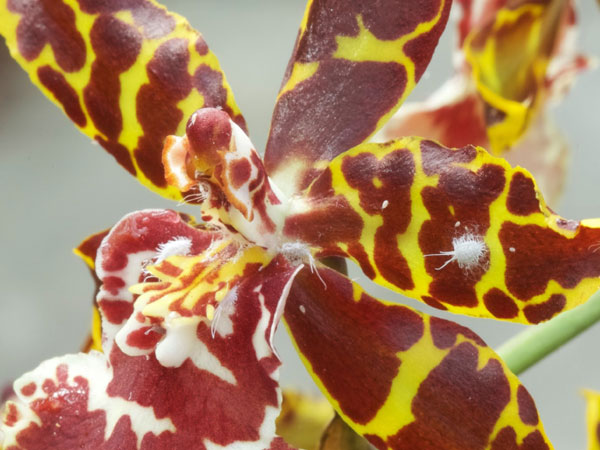As an avid orchid grower, I’ve dealt with my fair share of pesky critters lurking in the potting mix. If you’ve noticed tiny bugs crawling around the bark chunks or hiding in the moist sphagnum moss, you’re not alone! While some bugs are harmless, others can damage your orchid’s health.
In this comprehensive guide, we’ll cover how to identify common orchid pests prevent infestations, and safely get rid of any bugs in your potting medium. With the right approach you can create a bug-free environment for your orchid to thrive in.
Common Tiny Bugs in Orchid Mix
Here are the usual suspects that tend to infiltrate orchid potting blends:
Fungus Gnats
Fungus gnats are one of the most prevalent orchid pests. The tiny black flies are about 1/8 inch long and resemble mosquitoes They lay eggs in damp potting mix, and the larvae feed on fungus and plant roots Too many larvae can weaken the orchid’s root system.
Springtails
These tiny, jumping bugs measure only 1 to 2 mm long. They are common in potting soil, compost, and other moist environments. Springtails typically feed on decaying matter, fungi, and algae. Large numbers can damage new sprouts and tender roots, but they rarely harm mature orchids.
Sowbugs and Pillbugs
Sowbugs are grey crustaceans with a segmented shell, while pillbugs are a similar species that can roll into a ball. They munch on decaying matter in the potting mix. Their chewing can harm new roots and shoots, but they pose little risk to established plants.
Scale Insects
These immobile pests attach themselves to leaves and stems to feed on plant juices. Look for clusters of small bumps that appear white, brown, black, or pink. Severe infestations can stunt orchid growth and flower production.
Mealybugs
Mealybugs are soft-bodied insects covered in a white waxy coating. They look like tiny cotton balls clinging to the orchid’s leaves and stems. Mealybugs suck nutrients through the plant tissues, leading to weakness and wilting.
Thrips
Thin brown or black bugs about 1 to 2 mm long, thrips have fringed wings. They rasp the plant cells and drink the exuding sap. Leaves damaged by thrips take on a stippled, silvery appearance. They can spread viruses between plants.
Spider Mites
Too small to see with the naked eye, spider mites form webs on the underside of leaves. Their feeding causes yellow stippling on the upper leaf surface. Heavy infestations can stunt the plant and cause leaf drop.
Now that we’ve covered the usual suspects, let’s talk prevention and control methods.
Preventing Pest Infestations in Orchid Mix
Here are some key tips for keeping bugs at bay:
- Sterilize all potting materials before use by baking bark/moss for 30 minutes at 200°F. This kills any eggs or larvae.
- Remove old orchid mix entirely when repotting, don’t just top off. Old mix contains more bug eggs.
- Allow the potting mix to dry out moderately between waterings. Dampness attracts fungus gnats.
- Use a pot with excellent drainage holes to prevent moisture buildup.
- Provide good air circulation with fans to discourage insects.
- Inspect plants closely each week for early signs of pests like webs or bumps.
- Isolate new orchid acquisitions for 2-4 weeks before placing near other plants.
- Apply a systemic insecticide at the start of the growing season to kill sucking/chewing pests.
- Use yellow sticky traps near plant pots to catch adult fungus gnats.
With vigilance and preventative care, you can avoid most orchid pest problems altogether. But what if bugs still sneak in?
Getting Rid of Bugs in Orchid Potting Mix
If you spot bugs crawling through your orchid’s potting medium, take action right away before they multiply. Here are some effective organic and chemical controls:
- Remove and replace the top 1-2 inches of mix, which likely contains the most eggs/larvae.
- Sprinkle a light layer of diatomaceous earth on the soil surface to slice up soft-bodied insects.
- Water with a hydrogen peroxide solution (1 part peroxide, 4 parts water) to kill larvae.
- Apply insecticidal soap or neem oil spray to control adult gnats, mites, thrips, and other bugs.
- Introduce beneficial nematodes and predatory mites that consume pest larvae and eggs.
- Repot the orchid in a sterile mix and clean the pot thoroughly to eliminate hiding bugs.
- As a last resort, use a targeted pesticide like pyrethrins to kill stubborn infestations.
No matter what treatment method you choose, always follow label directions carefully. Test new products on a small area first to ensure they won’t harm your orchid variety. With persistence and the right tools, you can knock out those pesky bugs and get your orchid growing healthy again!
Orchid Q&A #45 – Soil insects, yellowing flower spikes, crinkly leaves & more!
FAQ
How do I get rid of gnats in my orchid soil?
How to get rid of orchid bugs?
What are orchid mites?
- The Ultimate Guide to Growing Strawberries in Raised Beds - August 8, 2025
- No-Dig Garden Beds: The Easiest Way to Grow a Beautiful Garden - August 6, 2025
- How to Protect and Preserve Wood for Raised Garden Beds - August 6, 2025

